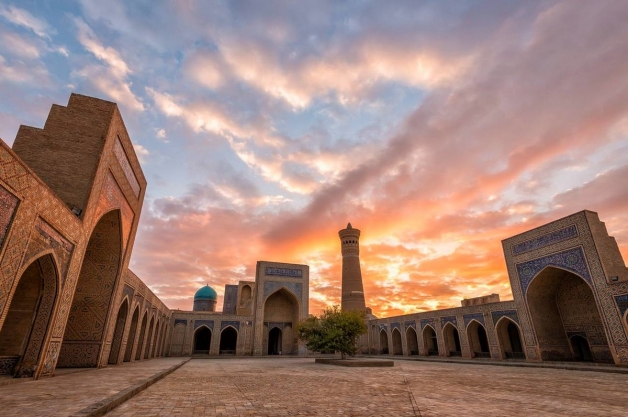BUKHARA CITY | BUKHARA HISTORY
Bukhara, Uzbekistan
Bukhara, Uzbekistan, is one of the largest and oldest cities in the country, a religious, cultural, and tourist center. Samarkand is the beauty of the earth, but Bukhara is the beauty of the Oriental spirit. The Great Silk Road ran through the city, and 60 caravanserais for foreign merchants operated within its borders. The goods produced here were famous for their reference quality, so local artisans did not experience difficulties with the sale of products. The fabrics woven here were valued so highly that they were used for paying taxes to the caliph.
The heritage of the Silk Road has endowed the city with color and originality. The population of the multiethnic city is 300 thousand people. Uzbeks, Tajiks, Turkmens, Arabs, Iranians, Russians, and Jews - each of these peoples has contributed a unique piece of culture to the spirit of the city.
The historian of the X century Narshakhi narrates that no city on earth had so many names. The ancient belief says that the Light from heaven descends on all the cities, and only from Bukhara does it rise to the sky. Travel writers, chroniclers, and historians agree - the Holy, the Noble, the Dome of Islam, the Pillar of Religion, the beauty of the spirit, the most intact city in the hoary East, and the world. It is still considered that Bukhara is a stronghold of Islam. There are 2076 mosques located here, and educational institutions - madrasahs have been functioning since the Middle Ages to this day, giving the world a galaxy of outstanding theologians.
Scientists have not come to a consensus on the origin of the city name. Bukhara is consonant with vihara, which in Sanskrit means monastery. A version with the Chinese word Bihar is considered too, which means a place of worship to idols. The daughter of the Chinese king was brought here as a bride. And the pagoda with idols was brought together with her. You can read it in the book of Fasl Abul-Hassan Abdul-Rahman, the son of Muhammad-an-Nishapuri, Treasures of Sciences.
Previously, there was a swampy area, a lowland overgrown with reeds and trees. At the same time, snow was melting from the Samarkand mountains, and the water flowing down fertilized the earth. Green meadows attracted flocks of birds, and people also came next to them. Thus appeared the first kishlaks: Nur, Kharkan-rud and Vardana, Taravdzha, Safna and Isvana, where the city will be built after a while.
History
The legend of the city origin is based on the name Siyavush - the son of the Iranian king, who built the Ark fortress here, around which the city grew. But for real its growth has for centuries depended upon its strategic location on the crossroads to Merv, Gurganj, Herat, Kabul, and Samarkand. Siyavush also strengthened ties with the local nobility by marrying the daughter of King Afrosiab.
The old city was founded before our era – it is a living monument of ancient civilizations. Tourists will learn about the rich history of Bukhara through a scattering of historical sights, as well as cult, sacred places of pilgrimage. Bukhara, the capital of the great kingdom of the Samanids, is not inferior to Samarkand by the solidity of its age exceeding 2500 years, nor by the significance of the preserved sights. Time has been merciful to the city, preserving the legacy of antiquity for posterity in such a great state that only a city located on the edge of the desert can count. The withering sun, the shortage of water resources – the city stood up against everything.
The same applies to the raids of the conquerors, among which Genghis Khan had the most destructive influence.
Samanids Bukhara
By the late ninth century, internal dissent of the Arab Empire had transformed into a weakening of power on its fringes. The local Iranian governors broke with the caliphate. Then, Ismael ibn Ahmed founded the Samanid dynasty and ushered in a golden age whose commercial and cultural vitality soon attracted the finest intellectuals of the time. Ibn-Sina, al-Beruniy, the historian Narshaki and poet Rudaki all served to turn the city into the center of a Persian renaissance and of Islamic science. Persian poetry fused with court Arabic as the city’s library expanded to become the most famous in the Islamic world. Bukhara city became “embellished with the rarest of high attainments … the meeting place of the highest intellectuals of the age, the horizon of the literary stars of the world”. The scholar of Arab Origin As-Saalibi calls Samanids Bukhara the abode of glory. It was the time when city and trade flourished, residents were exempt from paying taxes, and the population exceeded all other settlements of Transoxiana.
The Samanid Mausoleum and the park of the same name are places revered by Bukharians to visit. It is a way to pay tribute to the dynasty that laid the canonical architectural appearance of the city.
By the 11th century, the urban Persian yielded to the nomadic Turkmen. In 999, the Samanids fell to the Karakhanids and the Khorezmshah in 1206. The Chashma Ayub, Kalon Minaret, and Namazgokh Mosque were all added to the city thanks to them.
The Mongol invasion
In March 1220, the Mongol tide of calamity was spotted outside the city’s gates, its troops more numerous than locusts, each detachment like a billowing sea. The conquest was by no means a military achievement. High and resistant walls with a circumference of 1.5 km encircled the city citadel. The selfless warriors defending it made the fortress impregnable at all. But Genghis Khan still managed to take the city. It happened not as a result of defeat in a fair fight. It was the consequence of the treachery and cowardice of traitors.
Their leader Genghis Khan, The Wind of God’s Omnipotence, rode to the Namazgokh Mosque and proclaimed himself the Scourge of God. “If you had not committed great sins,” he said, “God would not have sent a punishment like me”.
“From the reflection of the sun, the plain seemed to be a tray filled with blood.” A refugee who finally managed to escape to Khorasan said of the massacre: They came, they sapped, burnt, slew, plundered, and they departed. The city was plundered; all buildings were burned to the ground. All of them, except for the Kalyan minaret. Before its greatness, Genghis Khan had to bow his head.
But neither then, nor ever after, did the proud and freedom-loving Bukharans put up with oppression, and any next government was afraid of people unrest.
The city took a century to recover from the trauma, at which point it was taken, destroyed, and depopulated by the Persian Khan Abaqa II. By 1366 Ibn-Battuta recorded that a few of its mosques, academies, and bazaars were lying in ruins. The once holy city had a reputation for fanaticism, falsehood, and denial of the truth.
The Timurids reconstructed the Chashma-Ayub mausoleum, the sacred source of the biblical Job. The Shaybanids revived the importance of the city, returning it to the status of the capital of the empire.
Shaybanids
In 1500 the Uzbek clan leader Mohammed Shaybani Khan entered the city and murdered its ruler Ali, thus supplanting the squabbling Timurid line with his Uzbek dynasty. The Timurids rallied briefly under the return of Babur to Bukhara in 1511. On 12 December 1512, Babur and his Shi’ite Persian allies were routed in the pivotal battle of Gijduvan, and the Timurid leader fled Transoxiana forever. The Uzbeks were undisputed winners, and the city was its capital again, with the Oxus as the fragile border with Shi’ites Persia.
Abdullah Khan reunited the Uzbek clans with a reign of public order that ended decades of anarchy. Abdullah’s reign prepared the ground for the city’s second golden age, and his name grew to near-legendary proportions. The artisans from conquered Herat fuelled a flowering of decorative and miniature art.
After Russia annexed Astrakhan in 1552, the Mongol leader Yar Mohammed and his son Jan fled to Bukhara to found a new Uzbek family dynasty, the Janids or Astrakhanids, who ruled for the next 150 years. As overland, continental trade routes withered, and wars with Shi’ite Persia intensified Sunni city’s religious isolation, the khanate sank into economic stagnation and religious fanaticism.
Soviet and post-Soviet history of Bukhara
After the October Revolution, the city remained the capital of the Bukharan People's Soviet Republic. Later, the territory was divided between modern Uzbekistan, Turkmenistan, and Tajikistan. The city remained on the territory of Uzbekistan, but in addition to the Uzbek language, Tajik speech is still heard here, and Russian is the language of interethnic communication.
In the 90s, the historical center of Bukhara was included in the List of UNESCO World Cultural Heritage Sites. As the medieval geographer Mukaddasi said, this city is blessed for everyone who aspires to come here. A holy, warm, bright, hospitable city - you will want to walk endlessly along its ancient cobblestone streets, wandering and admiring. Historical films are shot in the squares - their atmosphere inspires artists and poets and gives photographers shots of pure art.
Bukhara Tours & Excursions in 2022
One-day Bukhara tours, as well as excursions as part of a multi-day trip to Uzbekistan.
Chain and boutique hotels in Bukhara from 3* to 5* with a location in the historical part of the city.
Sights of Bukhara
Brief description of the key sights of Bukhara
• Abu Hafs Kabir Mausoleum of the Venerable Imam
• Bolo Hauz architectural complex
• Faizabad khanaka
• Jami (Juma) - Friday Mosque
• Kalyan mosque as part of the architectural complex of the same name
• Kalyan minaret as part of the architectural complex of the same name
• Khoja-Gaukushon architectural ensemble
• Khoja Zainuddin complex with Mosque-khanaka
• Kukeldash madrasah
• Lyabi Hauz architectural complex
• Magoki-Attori Mosque
• Miri-Arab Madrasah
• Poi-Kalon architectural ensemble
• Registan is an ancient city square with a central location
• Samanids mausoleum and place of worship of an outstanding ruling dynasty
• Sayfiddin Boharzi Mausoleum
• Trading domes
• Ulugbek - madrasah, one of the three that were built by the grandson of Amir Timur
Sights of Bukhara: Vicinity
• Chor-Bakr – necropolis and memorial complex
• Emir's Palace, Kagan
• Jeyran - Eco center
• Naqshbandi - Memorial complex
• Sitorai Mokhi-Khosa - palace, the suburban summer residence of the Emir
Bukhara Museums
Bukhara Museums - a brief description
• State Architectural Art Museum-Preserve
• Fayzulla Khodzhayev House-Museum
Folklore show
Railway Station
History of Bukhara
The climate
Transfers to airport/train station/hotel









